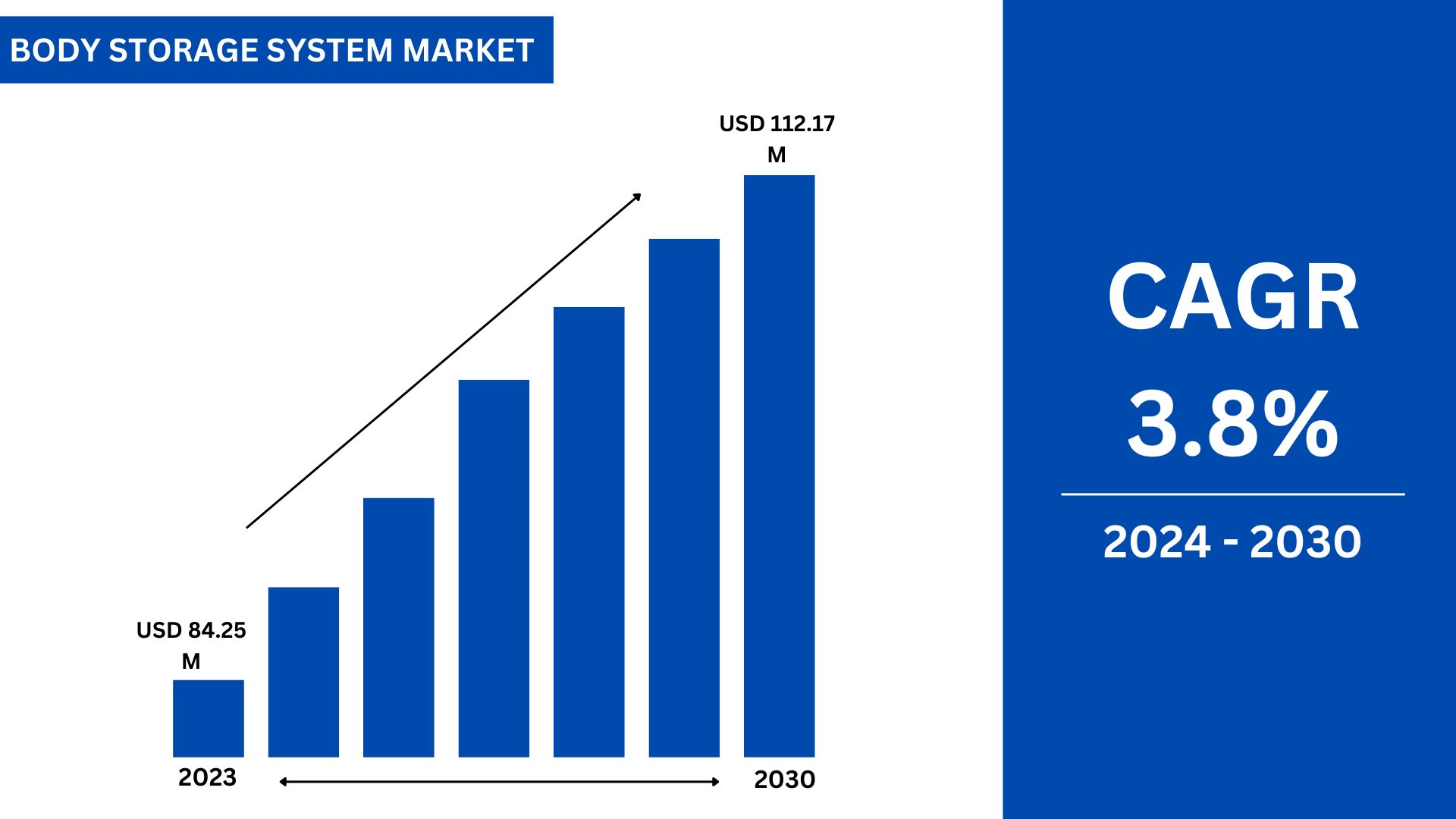TOP CATEGORY: Chemicals & Materials | Life Sciences | Banking & Finance | ICT Media

Download Report PDF Instantly
Report overview
Market Value and Growth: The market was valued at USD 84.25 million in 2023 and is projected to reach USD 112.17 million by 2030, with a Compound Annual Growth Rate (CAGR) of 3.8% during the forecast period (2024-2030). This indicates moderate growth in the demand for body storage systems globally.
Influence of COVID-19: The COVID-19 pandemic had significant impacts on healthcare systems and mortuary services, including the body storage system market. Surges in fatalities and overwhelmed healthcare facilities necessitated temporary morgue facilities and increased demand for body storage systems. However, the market may have experienced fluctuations due to disruptions in supply chains and changes in healthcare priorities.
Impact of the Russia-Ukraine War: The Russia-Ukraine War likely influenced the body storage system market through disruptions in the supply chain, currency fluctuations, and geopolitical tensions affecting healthcare infrastructure and investment. However, the extent of this impact would depend on various economic and political variables.
Technological Advancements: Advances in body storage system technology focus on improving storage capacity, preservation methods, and space efficiency. Innovations such as modular storage solutions, temperature and humidity control systems, and RFID tracking enhance the functionality and reliability of body storage facilities, driving market growth.
Healthcare Infrastructure: The demand for body storage systems is closely linked to the capacity and quality of healthcare infrastructure, including hospitals, morgues, forensic facilities, and funeral homes. Investments in healthcare infrastructure development, particularly in emerging economies, contribute to market growth by expanding the need for modern body storage solutions.
Regulatory Compliance: Compliance with regulatory standards and guidelines for body storage and mortuary practices is essential for manufacturers and operators of body storage systems. Adherence to regulations regarding sanitation, temperature control, and respect for human remains ensures the safety, dignity, and legal compliance of storage facilities.
Demographic Trends: Population growth, aging demographics, and urbanization influence the demand for body storage systems. Increasing mortality rates associated with aging populations and urbanization-related factors such as accidents and disasters drive the need for efficient and scalable body storage solutions in both developed and developing regions.
Geographical Variation: Market dynamics vary across regions due to differences in healthcare infrastructure, cultural practices, regulatory frameworks, and mortality rates. Developed regions with established healthcare systems and stringent regulations dominate the market, while emerging economies present growth opportunities driven by infrastructure development and rising healthcare standards.
Challenges and Opportunities: Challenges such as limited funding for healthcare infrastructure, cultural sensitivities surrounding death and mourning practices, and regulatory complexities may hinder market growth. However, opportunities exist in addressing unmet needs for modern body storage solutions, developing affordable and scalable products, and expanding into emerging markets with growing healthcare demands.

The USA market for Global Body Storage System market is estimated to increase from USD million in 2023 to reach USD million by 2030, at a CAGR during the forecast period of 2023 through 2030.
The China market for Global Body Storage System market is estimated to increase from USD million in 2023 to reach USD million by 2030, at a CAGR during the forecast period of 2023 through 2030.
The Europe market for Global Body Storage System market is estimated to increase from USD million in 2023 to reach USD million by 2030, at a CAGR during the forecast period of 2023 through 2030.
The U.S. Market is Estimated at $ Million in 2023, While China is Forecast to Reach $ Million.
Temporary Segment to Reach $ Million by 2030, with a % CAGR in next six years.
The global key manufacturers of Body Storage System include Flexmort, Nutwell, Mopec, AFOS, Colsec, Mortech, PMT Scientific and Kenyon Group, etc. in 2023, the global top five players have a share approximately % in terms of revenue.
This report aims to provide a comprehensive presentation of the global market for Body Storage System, with both quantitative and qualitative analysis, to help readers develop business/growth strategies, assess the market competitive situation, analyze their position in the current marketplace, and make informed business decisions regarding Body Storage System. This report contains market size and forecasts of Body Storage System in global, including the following market information:
MARKET MONITOR GLOBAL, INC (MMG) has surveyed the Body Storage System manufacturers, suppliers, distributors and industry experts on this industry, involving the sales, revenue, demand, price change, product type, recent development and plan, industry trends, drivers, challenges, obstacles, and potential risks.
Total Market by Segment:
Global Body Storage System Market, by Type, 2019-2024, 2025-2030 ($ Millions) & (K Units)
Global Body Storage System Market Segment Percentages, by Type, 2023 (%)
Global Body Storage System Market, by Application, 2019-2024, 2025-2030 ($ Millions) & (K Units)
Global Body Storage System Market Segment Percentages, by Application, 2023 (%)
Global Body Storage System Market, By Region and Country, 2019-2024, 2025-2030 ($ Millions) & (K Units)
Global Body Storage System Market Segment Percentages, By Region and Country, 2023 (%)
Competitor Analysis
The report also provides analysis of leading market participants including:
Further, the report presents profiles of competitors in the market, key players include:
Outline of Major Chapters:
Chapter 1: Introduces the definition of Body Storage System, market overview.
Chapter 2: Global Body Storage System market size in revenue and volume.
Chapter 3: Detailed analysis of Body Storage System manufacturers competitive landscape, price, sales and revenue market share, latest development plan, merger, and acquisition information, etc.
Chapter 4: Provides the analysis of various market segments by type, covering the market size and development potential of each market segment, to help readers find the blue ocean market in different market segments.
Chapter 5: Provides the analysis of various market segments by application, covering the market size and development potential of each market segment, to help readers find the blue ocean market in different downstream markets.
Chapter 6: Sales of Body Storage System in regional level and country level. It provides a quantitative analysis of the market size and development potential of each region and its main countries and introduces the market development, future development prospects, market space of each country in the world.
Chapter 7: Provides profiles of key players, introducing the basic situation of the main companies in the market in detail, including product sales, revenue, price, gross margin, product introduction, recent development, etc.
Chapter 8: Global Body Storage System capacity by region & country.
Chapter 9: Introduces the market dynamics, latest developments of the market, the driving factors and restrictive factors of the market, the challenges and risks faced by manufacturers in the industry, and the analysis of relevant policies in the industry.
Chapter 10: Analysis of industrial chain, including the upstream and downstream of the industry.
Chapter 11: The main points and conclusions of the report.